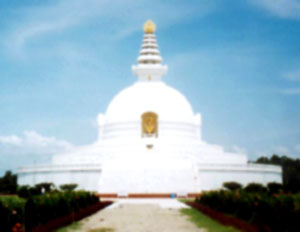 Gautama Buddha was born as Tathagata in Lumbini. It is situated in the Rupandehi District of Nepal. The place is quite close to Indian border. Gautama Buddha was known by several names and one of this is Tathagata meaning one who has found the Truth. Son of king Suddhodhana and Mayadevi the child was destined to become an Enlightened One in his later stage. Today Lumbini is one of the most popular Buddhist pilgrimage centres in Asia. There are several temples in Lumbini. One of the well known ones being the Mayadevi Temple. The Puskarini pond also lies nearby. Pilgrims also visit the ruins of Kapilavastu from this place.
Gautama Buddha was born as Tathagata in Lumbini. It is situated in the Rupandehi District of Nepal. The place is quite close to Indian border. Gautama Buddha was known by several names and one of this is Tathagata meaning one who has found the Truth. Son of king Suddhodhana and Mayadevi the child was destined to become an Enlightened One in his later stage. Today Lumbini is one of the most popular Buddhist pilgrimage centres in Asia. There are several temples in Lumbini. One of the well known ones being the Mayadevi Temple. The Puskarini pond also lies nearby. Pilgrims also visit the ruins of Kapilavastu from this place.
According to Parinibbana Sutta Buddha himself named four places for pilgrimage for the future. Those were the places of his birth, enlightenment, first discourse and death. Buddha passed through all these stages in his life in the lap of nature. It is also a probable reason why Buddhists are concerned about nature and environment.
When Buddha was born Lumbini was a beautiful park located between Devdaha and Kapilavastu. In the Sutta Nipata it is mentioned that Gautama was born in Lumbineyya Janapada where the Sakyan Village is located. Lumbini garden was then owned by Shakya and Kolia dynasties. Tathagata was born under one of Sal trees in the Lumbini Park. Mayadevi gave birth to the child on her way back from her parent`s home. Thus the Enlightened One ushered into the world in May 642 BC.
Later a nativity scene was installed by Malla Kings of the Naga dynasty in around 11th to 15th Centuries. The picture depicts Mayadevi holding onto a branch of a Sal tree with her right hand and holding a newborn child standing on a lotus petal and surrounded by a halo. Two heavenly beings are seen to shower water and lotuses from a vessel as is indicated by the description of the clouds. Today Buddhist pilgrims from all over the world visit Lumbini to witness the holy site where their sage was born. Lumbini was declared the World Heritage Site by UNESCO.
Buddha stayed in Lumbini when he visited Devdaha for delivering sermons. A pillar is found placed at this place to mark the visit of Emperor Ashoka. According to an inscription on this pillar it had been placed here by the people in charge of the park to memorialize the emperor`s visit. The park was earlier known as Rummindei Park. It is located two miles north of Bhagavanpur. However Ashoka himself, too, built four pillars in stone with a figure of horse on top.
According to one of the inscriptions on these stone pillars, "King Piyadasi (Ashoka), beloved of devas, in the 20 year of the coronation, himself made a royal visit, Buddha Sakyamuni having been born here, a stone railing was built and a stone pillar erected to the Bhagavan having been born here, Lumbini village was taxed reduced and entitled to the eight part."
Apart from being the birthplace of Lord Buddha the other major attraction of Lumbini is the Maya Devi Temple. It was discovered by a German archaeologist Feuhrer in 1895. Carvings on Buddha`s birth were discovered during the excavation. Some of the scholars believe that the temple was constructed over other temples or stupas. It is speculated that the temple was probably built on Ashoka`s pillars. On the south of the Maya Devi temple lies the famous bathing pool Puskarni. It is considered as a scared pond by the devotees as it is said that Mayadevi took a bath in this pond before giving birth to Tathagata.
Lumbini, even today, remains a major pilgrimage center for Buddhists.




















